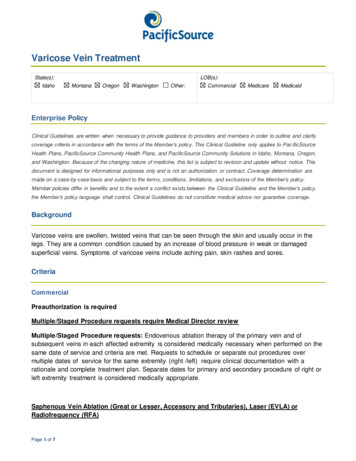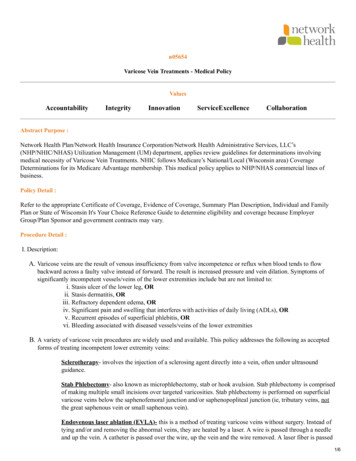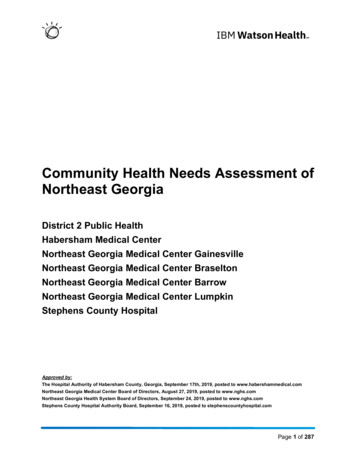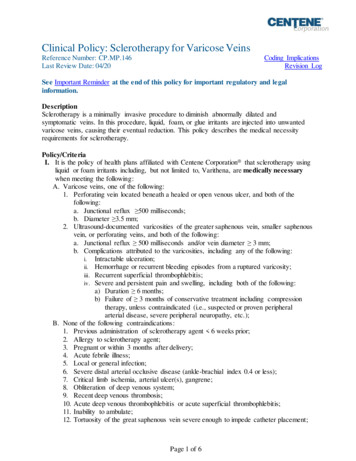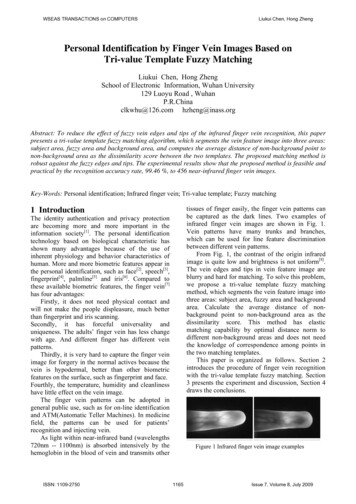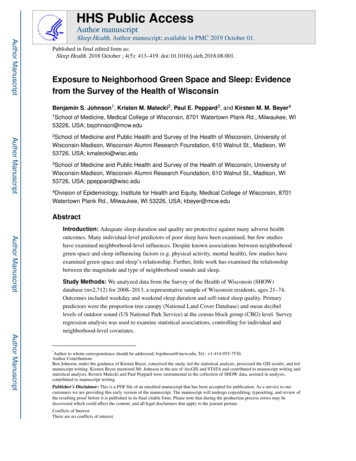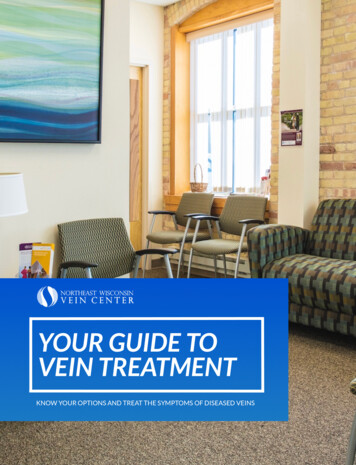
Transcription
YOUR GUIDE TOVEIN TREATMENTKNOW YOUR OPTIONS AND TREAT THE SYMPTOMS OF DISEASED VEINS
EFFECTIVE TREATMENTTHAT IS RIGHT FOR YOUWe are pleased to offer multiple types of vein treatment at Northeast Wisconsin Vein Center, so thatpatients have access to a variety of leading optionsto provide relief from the symptoms of vein disease,including: Varicose Veins Spider Veins Deep Vein ThrombosisThis guide provides those interested in learningmore about treatment options with an overview ofthose offered at our clinic.
ENDOVENOUS LASER TREATMENT (EVLT)Endovenous Laser Treatment at Northeast Wisconsin Vein Center utilizesthe latest VenaCure EVLT technology, using ultrasound to insert a laser fiber directly into the diseased vein under local anesthesia. This vein ablationprocess collapses the diseased vein wall through a precise dose of laser energy and reroutes blood flow to other functional veins nearby. The increasedcirculation provided by collapsing the varicose vein results in greatly reducedsymptoms and gives the affected legs and feet a healthier appearance. The entire procedure is completed within one hour at our clinic, after which time patients are able to walk out with immediate relief.The VenaCure EVLT treatment also results in little-to-no scarring afterwards, which can differ greatly from other more invasive forms of vein treatment. Patients are able to literally be back on their feet immediately followingthe procedure, in many cases with only slight discomfort, if any at all. With a98% success rate, EVLT offers an effective alternative to more invasive treatment options. This allows patients to get back to enjoying life without the setbacks associated with varicose veins.2
MICROPHLEBECTOMYMicrophlebectomy (also known as “mini phlebectomy” or “ambulatory phlebectomy”) is the removal of varicose veins through tiny incisions in the skin. The incisions are smaller than the sizeof a freckle, resulting in quick healing and no unsightly scars. This procedure is often performedwith other vein treatments such as laser therapy (EVLT) and sclerotherapy for several reasons:to reduce inflammation from trapped blood, to decrease the likelihood those varicose veins willcome back, and to lower the number of subsequent vein treatments needed.3
Microphlebectomy is performed by first applying a local anesthetic to the treatment area. Next,the target veins are removed with a pencil-sized tool that looks like a tiny crochet hook. Finally,a dressing is applied to the treatment area and the leg wrapped with an elastic bandage.Like sclerotherapy, microphlebectomy is a low-risk procedure. The most common side effect oftreatment is some bruising and soreness in the treatment area that responds well to cool compresses, Tylenol and ibuprofen. Tingling, numbness and other symptoms related to nerve irritation after the procedure are very rare. Skin infection is also rare.4
SCLEROTHERAPYIn sclerotherapy, an ultrasound unit or special light is used to guide a tiny needle into the abnormal veins. Once in the vein, a small amount of medication is injected that causes the inside ofthe vein walls to scar together. After these malfunctioning veins close down, they can no longerstretch out causing leg discomfort and prominent skin veins.Sclerotherapy is used to treat a wide variety of abnormal veins—veins as large as an inch tosmaller than a millimeter in size. There are some differences in the way we treat these differentkinds of veins.Which Types of Veins Can Be Treated with Sclerotherapy?Large VeinsLarge varicose veins are the tortuous, bumpy veins often seen along the inner thigh and calf.Sclerotherapy of these larger varicose veins is often combined with procedures that target thesource of abnormal blood flow into the leg veins. If the veins of the legs are thought of as a tree,5
either laser therapy, medical adhesive or another compound are used to close the tree“trunk” (the saphenous veins) while the“branches” of the tree (the varicose veins) aretreated with sclerotherapy. The benefit of performing sclerotherapy at the time of truncal(saphenous) vein treatment is that the injected medication spreads throughout the network of smaller branches in the legs, successfully treating these abnormal veins too. It alsoreduces the likelihood of needing additionalvein treatments in the future.abnormal veins can be treated during a singlesession. Sherry Konen, APNP, has extensivetraining and experience in the treatment ofthese veins and performs them at our Center.Perforator VeinsPerforator veins are usually invisible at theskin surface but can cause high blood pressure in the veins underneath the skin by abnormally shunting blood to them from thedeep veins. Incompetent perforator veins areoften treated by ultrasound-guided sclerotherapy and can result in quick healing of skin ulMost sclerotherapy of large veins is percers and other changes caused by malfunctionformed under ultrasound guidance. With ultraing veins.sound, we have the ability to confirm the precise location that the medication is injected aswell as its distribution throughout the treatedvein. At the Northeast Wisconsin Vein Center,we use a foamed medication, which has beenproven to result in better long-term closure ofthe veins, to require less medication and to improve visualization during the procedure.Small VeinsSmall veins include spider veins (telangiectasias) and reticular veins, both of which appearas a cluster of tiny blue or red lines beneaththe skin surface. These are often seen on theouter side of the thigh and leg and around theankle. These veins are treated using a speciallamp and a tiny needle (almost the size of a human hair) to inject a medication that causesthem to close down. Multiple patches of these6
VARITHENAVarithena (polidocanol injectable foam) is a prescription medicine used to treat varicose veinscaused by problems with the great saphenous vein (GSV) and other related veins in the leg’sGSV system. Varithena improves symptoms related to or caused by varicose veins, and the appearance of varicose veins.Unlike some therapies, Varithena : Is effective to treat veins of different sizes above and below the knee Requires no incisions, sedation or general anesthesia7
Does not require a wire to be inserted alongthe length of your vein Is administered in as little as one or two needle sticks per treatment, instead of 10-14 Does not use heat, eliminating the risk ofthermal injury Does not use glue and dissolves in the bloodstream after treatment, leaving no foreignbodies in the veinBecause Varithena is minimally invasive andwell tolerated by most patients, you may resume most normal activities the same day astreatment.How Does Varithena Work? The doctor administers a small amount ofVarithena (polidocanol injectable foam)through a catheter or by direct injectioninto the malfunctioning vein The foam fills and treats the desired sectionof the vein The diseased vein collapses and the foam isdeactivatedHow Is Blood flow Affected? When the malfunctioning vein collapses,blood flow shifts to healthier veins nearby.About Vein Treatment withVarithena Treatment with Varithena is minimally invasive and nonsurgical (no incisions required).The doctor usually numbs the injection site,but no additional anesthesia is required. It usually takes the doctor less than an hourto administer Varithena . Patients may resume some activities thesame day as treatment. Heavy exerciseshould be avoided for one week. Posttreatment bandages need to be kept dry andin place for 48 hours, and compression stockings must be worn on the treated leg for 2weeks. For a month, patients should walk atleast 10 minutes a day and avoid long periods of inactivity. Some patients only need a single treatment.Additional treatment may be needed, depending on the number and size of veins tobe treated. Insurance carriers may cover varicose veintreatment. Coverage may depend on the severity of the varicose veins and symptoms.Your doctor’s office may be able to help youunderstand your coverage.8
VENASEALThe VenaSeal closure system is designed for closure of varicose veins that works by injecting avery small amount of medical adhesive (glue) inside of the vein. The vein is then compressedwith ultrasound and remains closed.Who Is Eligible for Venaseal ?The procedure can be used for a variety of patients suffering from superficial venous insufficiency / reflux. This is a condition where the valves in superficial veins do not work correctly potentially leading to varicose veins, swelling, skin changes and a variety of symptoms.What Happens Prior to Venaseal ?Patients will have a free consult with one of our doctors or nurse practitioners. Those with veindisease they will then be set up for a leg vein ultrasound. Following this, if they are a candidatefor Venaseal, the patient would be scheduled and the procedure would be discussed in detail.9
What to Expect During the Procedurefollow up appointment with ultrasound. Thiswill verify that the vein remained closed andThe VenaSeal closure procedure is performedwill address any concerns that you may have. Aas an outpatient in the comfortable setting offinal follow up office appointment with ultrathe Northeast Wisconsin Vein Center. The prosound will be performed around 4 months folcedure typically lasts 1-2 hours and only relowing the procedure in order to documentquires a small amount of local anesthetic (numblong term closure of the treated vein.ing medication).Is VenaSeal Safe?You may feel some minor pain or stinging at thenumbing site where the vein will be accessed.VenaSeal is FDA approved for the treatment ofA small hollow tubed catheter is them inserted superficial venous insufficiency / reflux. Allinto the vein which may cause mild pressure.medical procedures do have some minor risk,Using ultrasound, small amounts of painlessand VenaSeal carries very similar risk of the folmedical adhesive are given inside of the veinlowing, which are not more than similar proceand the vein walls are then shut together.dures designed to treat varicose veins: allergicSome mild pulling or tugging may be felt during reaction, deep vein thrombosis (DVT), bleedingthis portion.at the access site, darkening of the skin overlying the treated vein, infection at the access siteAfter treatment the catheter is removed and aand pain overlying the closed vein.small bandage or band aid is applied. Compression stockings do not need to be worn is the Ve- How is VenaSeal different from other procenaSeal procedure is performed alone withoutdures designed to close veins?other vein procedures.VenaSeal is the only FDA approved procedureCommon Questions About VenaSeal that uses injection of medical adhesive to closeveins. Because this adhesive works immediAfter the procedure you will walk for 10-15ately to cause venous closure as opposed tominutes in the clinic to be sure that you are reother procedures that involve thermal or chemicovering well. You will then be dischargedcal irritation of the inside of the vein but not imhome.mediate adhesive closure, compression stockings do not need to be worn following the VeOver the next couple of weeks you will need tonaSeal procedure. Because the entire length ofwalk and avoid very long periods of inactivity.Depending on your symptoms you may be able the vein is not heated, a much small amount ofto return to all normal activities very shortly fol- numbing medicine is used for VenaSeal, makinglowing the procedure. Within 2-3 weeks follow- it less painful and quicker than other vein closure options.ing the procedure, you will return to clinic for a10
TAKE THE NEXT STEP TOWARD TREATMENTADDRESS333 N. COMMERCIAL ST.SUITE 150NEENAH, WI 54956PHONE: (920) 486-1515HOURS: MONDAY - FRIDAY, 8AM - 5PMWWW.NORTHEASTWISCONSINVEINCENTER.COM11
the Northeast Wisconsin Vein Center. The pro-cedure typically lasts 1-2 hours and only re-quires a small amount of local anesthetic (numb-ing medication). You may feel some minor pain or stinging at the numbing site where the vein will be accessed. A small hollow tubed catheter is them inserted
